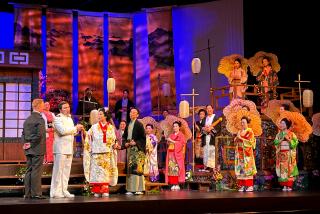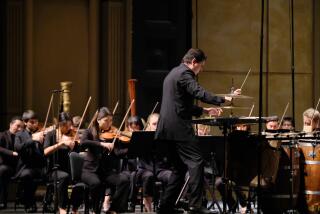Cloud of Caution Hangs Over Arts : Economy: Adventurous programming, chance-taking not high among groups’ priorities as recession forces bottom-line stance.
It was a coup for a rising young orchestra: the Southern California premiere of a major new work, John Corigliano’s First Symphony.
“I’m extremely proud that we did it,” said Louis G. Spisto, executive director of the Pacific Symphony, which performed the work at two subscription concerts in December. “It is important for an orchestra to do these things.”
But Spisto says the Pacific’s ability to pull off such events is beginning to suffer under the nation’s deepening recession. The Corigliano symphony was “more expensive to perform than the standard Beethoven or Brahms,” primarily because it required a larger orchestra; also, it doesn’t have the box-office draw of more conventional classical fare.
“It’s frustrating. Those are exactly the kinds of things we wish to be doing,” Spisto said. But the orchestra, like other arts organizations in Orange County and elsewhere, is being forced to look harder at bottom-line issues as it programs for the coming year, and beyond.
The economic slump, which started in mid-1990, will have a broadening impact on what county audiences see in the year ahead. Several organizations, wary of frightening off more fickle audiences, say they are shying from adventurous programming. At the same time, as sources of private funds continue to dry up, Orange County arts organizations--many of which already have made organizational cuts--are looking for ways to save money in production costs.
Art museums, for instance, are relying more on shows from their permanent collections--exhibits that are cheaper to mount than shows that gather works from other sources. Organizations that present touring attractions, meanwhile, also are feeling a secondary impact as national performing groups trim their schedules and the Broadway slump lingers.
In the case of the Pacific Symphony, whose 1992-93 programming is almost complete, the continuing recession will mean fewer works requiring “large-scale artistic forces” such as choral groups or expanded orchestras, for example.
“When we looked at certain things, we had to keep an eye on the cost,” Spisto said. “We might do two major things” instead of three. Also, the orchestra will rely less on bringing in big-name (read: expensive) soloists.
“I think we’ve really held the line in paying soloists,” Spisto says. The organization is being “smarter and wiser” in its use of soloists, “knowing who plays what well, rather than getting the biggest names,” he says.
The Orange County Philharmonic Society, likewise, will economize by relying less on star soloists and recitalists (such as scheduled 1991-92 appearances by soprano Jessye Norman and cellist Yo-Yo Ma).
“We probably will take a hiatus from presenting big-name soloists,” says Erich A. Vollmer, executive director of the Philharmonic Society.
While its chamber series at the Irvine Barclay Theatre--co-sponsored with the Laguna Chamber Music Society--has been a success, the society may be forced to drop its Festival chamber series at the same venue. The series drew disappointing subscription sales this season, and also lost its major underwriting contributor.
The Philharmonic Society has ruled out economizing in its orchestral series at the Orange County Performing Arts Center. But while Vollmer remains committed to bringing in the best available orchestras, he said he is feeling a secondary pinch from the worldwide economic slump as some top orchestras scale back their traveling plans.
“We are certainly able to put together a good season” for 1992-93, Vollmer said, but if all the groups that were supposed to tour would have followed through with their plans, “it would have been a blockbuster season.”
A case in point is the Leipzig Gewandhaus, the orchestra led by Kurt Masur that had been scheduled to open the Philharmonic Society’s season at the Center next fall. But the group canceled its entire U.S. tour because of funding troubles at home in Germany.
“That was really the anchor of one of our two orchestra series,” Vollmer said. “It was a real disappointment.”
While the Leipzig performances had not been announced, the situation recalls the September cancellation of American Ballet Theatre’s announced world premiere of its new production of “The Nutcracker,” scheduled for last month at the Orange County Performing Arts Center. Officials at the Center were able to line up an alternate “Nutcracker” at the last minute, courtesy of San Francisco Ballet, but the incident pointed out how vulnerable presenting organizations are to the widespread money woes of performing groups.
Although “fund-raising difficulties are increasing,” Center president Thomas R. Kendrick said he is more concerned about the “rapidly declining number of quality attractions.” The Center presents a dance series and a musical-theater series, and is seeing a dwindling number of options in both categories.
The ABT cancellation underscored the uncertainties in the dance realm, while touring musical-theater productions are progressively harder to come by as the Broadway slump continues. And because it takes so long to fund and produce a Broadway musical, the Center is likely to feel the effect for years to come.
“Every ‘Nick and Nora’ that falls only adds to that,” said Kendrick, referring to the recent musical version of “The Thin Man” books and movies that met a quick end on the Broadway stage.
With traditionally low levels of government support in Orange County, local arts groups are even more dependent on box-office revenue than organizations in many other areas of the country. Thus, the troubling economic times are leading in some instances to a renewed cautiousness in programming--in a county that is not known for artistic boldness in the best of times.
Opera Pacific will stick to “programming that is fairly conservative,” according to general director David DiChiera. “This is not a time for us to be programming anything that might be very new to an audience, at least for this year and the next.”
“We are not trying to bring in unrecognized names” in classical or popular music, said Yaakov Dvir-Djerassi, manager of the Orange County Symphony of Garden Grove, which previously has brought in guest soloists from both realms. “We can’t take chances with a new work; we can’t take chances with a new artist.”
Elsewhere in the county’s arts scene:
The Laguna Art Museum already has made programmatic changes to cope with tight budgets and will continue to do so. Showing more of its permanent collection has been a key strategy, and for 1992 it has scheduled three exhibits of those works.
“One reason is we’ve received a number of important gifts recently and want an opportunity to show (them) off, and quite frankly, it’s less expensive,” director Charles Desmarais said.
The museum also will continue to make other budget decisions, similar to those that enabled it to end this year in the black. For instance, this year it has opted against renewing its Contemporary California Composers program co-sponsored by UC Irvine, a poorly attended lecture series that would have gone into its third year. The series typically didn’t pay for itself in attendance fees.
At the Newport Harbor Art Museum, meanwhile, programming remains something of a sacred cow.
“There’s a sense that we are going to spread the burden elsewhere . . . anything but cut back programming,” said museum director Michael Botwinick.
The museum’s exhibit schedule is firm through early 1993, so it hasn’t had to deal heavily with long-term recessionary effects on programs.
Likewise, in the theater realm, South Coast Repertory’s programming is set for the coming year and thus far has escaped the effects of economic belt-tightening. If, however, the recession were to continue through next summer and beyond, producing artistic director David Emmes said the theater may begin selecting plays that require smaller casts or have less-expensive technical demands.
“That’s something we could do for a time, and I think we would not be shortchanging our audience in the short run,” Emmes said. “But ultimately, we’d be shortchanging ourselves and our audience if we limited ourselves to that. Artists need to exercise themselves in (large, full-scale) productions like ‘Twelfth Night,’ ” William Shakespeare’s comedy that begins previews at SCR tonight, “and our audience has the right to a full range” of theatrical experiences.
While the Laguna Playhouse won’t see a big change in programming--”We are always pretty conservative,” said executive director Richard A. Stein--the playhouse may also look to less-expensive productions if the recession continues.
“I’d say we are keeping a very close watch on expenses,” Stein said. “We don’t want to do anything that will jeopardize the quality of our work, so I guess at times that means we are looking at some production possibilities that would be less costly to mount.”
The one theater troupe that is looking to expand in the face of the ongoing recession is the Grove Shakespeare Festival, which not so long ago faced financial uncertainty. Managing director Barbara G. Hammerman said that the company is expanding its ’92 season to generate income during the first three months of the year when the theater is typically dark, but still incurring expenses.
“The organization has moved from a point in time in 1980 when it was a summer festival to a year-round professional organization, and we need to be producing year-round,” Hammerman said.
Expansion plans were set before the company received a windfall grant last week of $250,000--it’s biggest grant ever and more than one-quarter of its $800,000 annual budget--from the newly active Leo Freedman Foundation. That money cemented plans to add three staffers to the Grove’s pared-down administration. Three years ago, it cut staff down to five from 12.
Another organization that is taking an optimistic tact in planning its 1992-93 season is the Pacific Chorale. The chorale is planning “several major projects” to mark its 25th-anniversary season.
“I think we’re going to go ahead and gamble on it because we’ve come through this well” in 1991, said music director John Alexander.
None of the organizations surveyed, meanwhile, say they have immediate plans to cut into outreach budgets.
“We certainly don’t see any cutbacks in that area,” said Vollmer, who added that the Philharmonic Society will, in fact, put more emphasis on funding its well-regarded education programs.
Said Newport Harbor’s Botwinick: “It’s one area, one hopes, where we can find new and non-traditional sources of funding.”
But even that department could suffer at the Laguna Art Museum, said director Desmarais, citing the precarious position of a program it sponsors called “Art From the Museum,” which brings art to local schools. The program was run by a part-time employee who recently fell ill and left the job. The employee might not be replaced in order to save money, Desmarais said.
“We’re doing everything we can to avoid (those kinds of measures), but when push comes to shove, you are going to focus in the last analysis on the programs on site, so our fallback position is to come home,” he said.
More to Read
The biggest entertainment stories
Get our big stories about Hollywood, film, television, music, arts, culture and more right in your inbox as soon as they publish.
You may occasionally receive promotional content from the Los Angeles Times.










